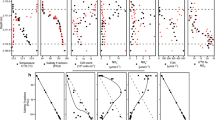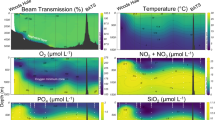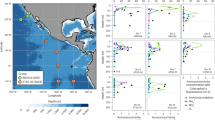Abstract
Mesophilic Crenarchaeota have recently been thought to be significant contributors to nitrogen (N) and carbon (C) cycling. In this study, we examined the vertical distribution of ammonia-oxidizing Crenarchaeota at offshore site in Southern Tyrrhenian Sea. The median value of the crenachaeal cell to amoA gene ratio was close to one suggesting that virtually all deep-sea Crenarchaeota possess the capacity to oxidize ammonia. Crenarchaea-specific genes, nirK and ureC, for nitrite reductase and urease were identified and their affiliation demonstrated the presence of ‘deep-sea’ clades distinct from ‘shallow’ representatives. Measured deep-sea dark CO2 fixation estimates were comparable to the median value of photosynthetic biomass production calculated for this area of Tyrrhenian Sea, pointing to the significance of this process in the C cycle of aphotic marine ecosystems. To elucidate the pivotal organisms in this process, we targeted known marine crenarchaeal autotrophy-related genes, coding for acetyl-CoA carboxylase (accA) and 4-hydroxybutyryl-CoA dehydratase (4-hbd). As in case of nirK and ureC, these genes are grouped with deep-sea sequences being distantly related to those retrieved from the epipelagic zone. To pair the molecular data with specific functional attributes we performed [14C]HCO3 incorporation experiments followed by analyses of radiolabeled proteins using shotgun proteomics approach. More than 100 oligopeptides were attributed to 40 marine crenarchaeal-specific proteins that are involved in 10 different metabolic processes, including autotrophy. Obtained results provided a clear proof of chemolithoautotrophic physiology of bathypelagic crenarchaeota and indicated that this numerically predominant group of microorganisms facilitate a hitherto unrecognized sink for inorganic C of a global importance.
Similar content being viewed by others
Log in or create a free account to read this content
Gain free access to this article, as well as selected content from this journal and more on nature.com
or
Accession codes
References
Agogué H, Brink M, Dinasquet J, Herndl GJ . (2008). Major gradients in putatively nitrifying and non-nitrifying archaea in the deep North Atlantic. Nature 456: 788–791.
Altschul SF, Madden TL, Schaffer AA, Zhang J, Zhang Z, Miller W et al. (1997). Gapped BLAST and PSI-BLAST: a new generation of protein database search programs. Nucleic Acids Res 25: 3389–3402.
Amann R, Ludwig W, Schleifer K . (1995). Phylogenetic identification and in situ detection of individual microbial cells without cultivation. Microbiol Rev 59: 143–169.
Bartossek R, Nicol GW, Lanzen A, Klenk HP, Schleper C . (2010). Homologues of nitrite reductases in ammonia-oxidizing archaea: diversity and genomic context. Environ Microbiol 12: 1075–1088.
Beman JM, Popp BN, Francis CA . (2008). Molecular and biogeochemical evidence for ammonia oxidation by marine Crenarchaeota in the Gulf of California. ISME J 2: 429–441.
Berg IA, Kockelkorn D, Buckel W, Fuchs G . (2007). A 3-hydroxypropionate/4-hydrdoxybutyrate autotrophic carbon dixide assimilation pathway in Archaea. Science 318: 1782–1786.
Berg IA, Kockelkorn D, Ramos-Vera WH, Say RF, Zarzycki J, Hügler M et al. (2010a). Autotrophic carbon fixation in archaea. Nat Rev Microbiol 8: 447–460.
Berg IA, Ramos-Vera WH, Petri A, Huber H, Fuchs G . (2010b). Study of the distribution of autotrophic CO2 fixation cycles in Crenarchaeota. Microbiology 156: 256–269.
Brochier-Armanet C, Boussau B, Gribaldo S, Forterre P . (2008). Mesophilic Crenarchaeota: proposal for a third archaeal phylum, the Thaumarchaeota. Nat Rev Microbiol 6: 245–252.
Cantera JJ, Stein LY . (2007). Role of nitrite reductase in the ammonia-oxidizing pathway of Nitrosomonas europaea. Arch Microbiol 188: 349–354.
Carpenter JH . (1965). The accuracy of the Winkler method for the dissolved oxygen analysis. Limnol Oceanogr 10: 135–140.
Church MJ, Wai B, Karl DM, DeLong EF . (2010). Abundances of crenarchael amoA genes and transcripts in the Pacific Ocean. Environ Microbiol 12: 679–688.
Cole JR, Chai B, Farris RJ, Wang Q, Kulam SA, Mcgarrell DM et al. (2005). The Ribosomal Database Project (RDP-II): Sequences and tools for high-throughput rRNA analysis. Nucleis Acids Res 33: D294–D296.
De Corte D, Yokokawa T, Varela MM, Agogué H, Herndl GJ . (2009). Spatial distribution of Bacteria and Archaea and amoA gene copy numbers throughout the water column of the Eastern Mediterranean Sea. ISME J 3: 147–158.
de la Torre JR, Walker CB, Ingalls AE, Könneke M, Stahl DA . (2008). Cultivation of a thermophilic ammonia oxidizing archaeon synthesizing crenarchaeol. Environ Microbiol 10: 810–818.
Decembrini F, Caroppo C, Azzaro M . (2009). Size structure and production of phytoplankton community and carbon pathways channelling in the Southern Tyrrhenian Sea (Western Mediterranean). Deep-Sea Res II 56: 687–699.
DeLong EF, Preston CM, Mincer T, Rich V, Hallam SJ, Frigaard NU et al. (2006). Community genomics among stratified microbial assemblages in the ocean's interior. Science 311: 496–503.
Elsaied H, Naganuma T . (2001). Phylogenetic diversity of ribulose-1,5-bisphosphate carboxylase/oxygenase large subunit genes from deep-sea microorganisms. Appl Environ Microbiol 67: 1751–1765.
Erguder TH, Boon N, Wittebolle L, Marzorati M, Verstraete W . (2009). Environmental factors shaping the ecological niches of ammonia-oxidizing archaea. FEMS Microbiol Rev 33: 855–869.
Francis CA, Roberts KJ, Beman JM, Santoro AE, Oakley BB . (2005). Ubiquity and diversity of ammonia-oxidizing archaea in water columns and sediments of the ocean. Proc Natl Acad Sci USA 102: 14683–14688.
Gadelle D, Bocs C, Graille M, Forterre P . (2005). Inhibition of archaeal growth and DNA topoisomerase VI activities by the Hsp90 inhibitor radicicol. Nucleic Acids Res 33: 2310–2317.
Ginestet P, Audic J-M, Urbain V, Block J-C . (1998). Estimation of nitrifying bacterial activities by measuring oxygen uptake in the presence of the metabolic inhibitors allylthiourea and azide. Appl Environ Microbiol 64: 2266–2268.
Gupta RS, Shami A . (2010). Molecular signatures for the Crenarchaeota and the Thaumarchaeota. Antonie Van Leeuwenhoek, doi 10.1007/s10482-010-9488-3; Epub ahead of print.
Hallam SJ, Konstantinidis KT, Putnam N, Schleper C, Watanabe Y, Sugahara J et al. (2006a). Genomic analysis of the uncultivated marine crenarchaeote Cenarchaeum symbiosum. Proc Natl Acad Sci USA 103: 18296–18301.
Hallam SJ, Mincer TJ, Schleper C, Preston CM, Roberts K, Richardson PM et al. (2006b). Pathways of carbon assimilation and ammonia oxidation suggested by environmental genomic analyses of marine Crenarchaeota. PLoS Biol 4: e95.
Hatzenpichler R, Lebecleva EV, Spieck E, Stoecker K, Richter A, Daims H et al. (2008). A moderately thermophilic ammonia-oxidizing crenarchaeote from a hot spring. ProcNatl Acad Sci USA 105: 2134–2139.
Herndl GJ, Reinthaler T, Teira E, van Aken H, Veth C, Pernthaler A et al. (2005). Contribution of Archaea to total prokaryotic production in the deep Atlantic Ocean. Appl Environ Microbiol 71: 2303–2309.
Huber H, Gallenberg M, Jahn U, Eylert E, Berg IA, Kockelkorn D et al. (2008). A dicarboxylate/4-hydroxybutyrate autotrophic carbon assimilation cycle in the hyperthermophilic Archaeum Ignicoccus hospitalis. Proc Natl Acad Sci USA 105: 7851–7856.
Ingalls AE, Shah SR, Hansman RL, Aluwihare LI, Santos GM, Druffel ER et al. (2006). Quantifying archaeal community autotrophy in the mesopelagic ocean using natural radiocarbon. Proc Natl Acad Sci USA 103: 6442–6447.
Jolivet E, L’Haridon S, Corre E, Forterre P, Prieur D . (2003). Thermococcus gammatolerans sp. nov., a hyperthermophilic archaeon from a deep-sea hydrothermal vent that resists ionizing radiation. Int J Syst Evol Microbiol 53: 847–851.
Karner MB, Fuhrman J . (1997). Determination of active marine bacterioplankton: a comparison of universal 16S rRNA probes, autoradiography, and nucleoid staining. Appl Environ Microbiol 63: 1208–1213.
Karner MB, DeLong EF, Karl DM . (2001). Archaeal dominance in the mesopelagic zone of the Pacific Ocean. Nature 409: 507–510.
Kirchman DL, Elifantz H, Dittel AI, Malmstrom RR, Cottrell MT . (2007). Standing stocks and activity of Archaea and Bacteria in the western Arctic Ocean. Limnol Oceanogr 52: 495–507.
Könneke M, Bernhard AE, de la Torre JR, Walker CB, Waterbury JB, Stahl DA . (2005). Isolation of an autotrophic ammonia-oxidizing marine archaeon. Nature 437: 543–546.
Konstantinidis KT, Braff J, Karl DM, DeLong EF . (2009). Comparative metagenomic analysis of a microbial community residing at a depth of 4000 meters at station ALOHA in the North Pacific subtropical gyre. Appl Environ Microbiol 75: 5345–5355.
La Cono V, Smedile F, Ferrer M, Golyshin PN, Giuliano L, Yakimov MM . (2010). Genomic signatures of fifth autotrophic carbon assimilation pathway in bathypelagic Crenarchaeota. Microb Biotechnol 3: 595–606.
Lam P, Jensen MM, Lavik G, McGinnis DF, Müller B, Schubert CJ et al. (2007). Linking crenarchaeal and bacterial nitrification to anammox in the Black Sea. Proc Natl Acad Sci USA 104: 7104–7109.
Lam P, Lavik G, Jensen MM, van de Vossenberg J, Schmid M, Woebken D et al. (2009). Revising the nitrogen cycle in the Peruvian oxygen minimum zone. Proc Natl Acad Sci USA 106: 4752–4757.
MacPherson IS, Murphy ME . (2007). Type-2 copper-containing enzymes. Cell Mol Life Sci 64: 2887–2899.
Martens-Habbena W, Berube PM, Urakawa H, de la Torre JR, Stahl DA . (2009). Ammonia oxidation kinetics determine niche separation of nitrifying Archaea and Bacteria. Nature 461: 976–979.
Martin-Cuadrado AB, López-García P, Alba JC, Moreira D, Monticelli L, Strittmatter A et al. (2007). Metagenomics of the deep Mediterranean, a warm bathypelagic habitat. PLoS One 2: e914.
Martin-Cuadrado AB, Rodriguez-Valera F, Moreira D, Alba JC, Ivars-Martínez E, Henn MR et al. (2008). Hindsight in the relative abundance, metabolic potential and genome dynamics of uncultivated marine archaea from comparative metagenomic analyses of bathypelagic plankton of different oceanic regions. ISME J 2: 865–886.
Millot C, Candela J, Fuda J-L, Tber Y . (2006). Large warming and salinification of the Mediterranean outflow due to changes in its composition. Deep-Sea Res pI 53: 656–666.
Mincer TJ, Church MJ, Taylor LT, Preston C, Karl DM, DeLong EF . (2007). Quantitative distribution of presumptive archaeal and bacterial nitrifiers in Monterey Bay and the North Pacific Subtropical Gyre. Environ Microbiol 9: 1162–1175.
Ouverney CC, Fuhrman JA . (2000). Marine planktonic archaea take up amino acids. Appl Environ Microbiol 66: 4829–4833.
Park BJ, Park SJ, Yoon DN, Schouten S, Sininnghe Damsté JS, Rhee SK . (2010). Cultivation of autotrophic ammonia-oxidizing archaea from marine sediments in co-culture with sulfur-oxidizing bacteria. Appl Environ Microbiol 76: 7575–7587.
Pearson A, McNichol AP, Benitez-Nelson BC, Hayes JM, Eglinton TI . (2001). Origins of lipid biomarkers in Santa Monica Basin surface sediment: A case study using compound-specific D14C analysis. Geochimica et Cosmochimica Acta 65: 3123–3137.
Pérez MT, Pausz C, Herndl GJ . (2003). Major shift in bacterioplankton utilization of enantiomeric amino acids between surface waters and the ocean's interior. Limnol Oceanogr 48: 755–763.
Pernthaler A, Pernthaler J, Amann R . (2002). Fluorescence in situ hybridization and catalyzed reporter deposition for the identification of marine bacteria. Appl Environ Microbiol 68: 3094–3101.
Pikuta EV, Marsic D, Itoh T, Bej AK, Tang J, Whitman WB et al. (2007). Thermococcus thioreducens sp. nov., a novel hyperthermophilic, obligately sulfur-reducing archaeon from a deep-sea hydrothermal vent. Int J Syst Evol Microbiol 57: 1612–1618.
Rajagopal I . (2000). SOFTWARE: Genomics made easy. Science 290: 474.
Ribera d’Alcalà M, Brunet C, Convensano F, Corato F, Lavezza R . (2009). Nutrient and pigment distributions in the southern Tyrrhenian Sea during mid-summer and late fall 2005. Deep-Sea Res II 56: 676–686.
Rivaro P, Messa R, Massolo S, Frache R . (2010). Distributions of carbonate properties along the water column in the Mediterranean Sea: spatial and temporal variations. Mar Chem 121: 236–245.
Schleper C . (2008). Metabolism of the deep. Nature 456: 712–714.
Schloss PD, Handelsman J . (2005). Introducing DOTUR, a computer program for defining operational taxonomical units and estimating species richness. Appl Environ Microbiol 71: 1501–1506.
Sekar R, Fuchs BM, Amann R, Pernthaler J . (2004). Flow sorting of marine bacterioplankton after fluorescence in situ hybridization. Appl Environ Microbiol 70: 6210–6219.
Simon HM, Jahn CE, Bergerud LT, Sliwinski MK, Weimer PJ, Willis DK et al. (2005). Cultivation of mesophilic soil crenarchaeotes in enrichment cultures from plant roots. Appl Environ Microbiol 71: 4751–4760.
Spang A, Hatzenpichler R, Brochier-Armanet C, Rattei T, Tischler P, Spieck E et al. (2010). Distinct gene set in two different lineages of ammonia-oxidizing archaea supports the phylum Thaumarchaeota. Trends Microbiol 18: 331–340.
Tamburini C, Garel M, Al Ali B, Merigot B, Kriwy P, Charriere B et al. (2009). Distribution and activity of Bacteria and Archaea in the different water masses of the Tyrrhenian Sea. Deep-Sea Res pII 56: 700–712.
Teira E, Lebaron P, van Aken H, Herndl GJ . (2006). Distribution and activity of Bacteria and Archaea in the deep water masses of the North Atlantic. Limnol Oceanogr 51: 2131–2144.
Teira E, Reinthaler T, Pernthaler A, Pernthaler J, Herndl GJ . (2004). Combining catalyzed reporter deposition-fluorescence in situ hybridization and microautoradiography to detect substrate utilization by bacteria and archaea in the deep ocean. Appl Environ Microbiol 70: 4411–4414.
Thauer RK . (2007). A fifth pathway of carbon fixation. Science 318: 1732–1733.
Treusch AH, Leininger S, Kletzin A, Schuster SC, Klenk HP, Schleper C . (2005). Novel genes for nitrite reductase and Amo-related proteins indicate a role of uncultivated mesophilic crenarchaeota in nitrogen cycling. Environ Microbiol 7: 1985–1995.
Varela MM, van Aken HM, Sintes E, Herndl GJ . (2008). Latitudinal trends of Crenarchaeota and Bacteria in the meso- and bathypelagic water masses of the Eastern North Atlantic. Environ Microbiol 10: 110–124.
Venter JC, Remington K, Heidelberg JF, Halpern AL, Rusch D, Eisen JA et al. (2004). Environmental genome shotgun sequencing of the Sargasso Sea. Science 304: 66–74.
Walker CB, de la Torre JR, Klotz MG, Urakawa H, Pinela N, Arp DJ et al. (2010). Nitrosopumilus maritimus genome reveals unique mechanisms for nitrification and autotrophy in globally distributed marine crenarchaea. Proc Natl Acad Sci USA 107: 8818–8823.
Woodward EMS . (1994). Nanomolar Ammonia Concentrations in the Western Mediterranean Sea. 5th EROS 2000 Workshop: Hambourg, March 28–30.
Wuchter C, Abbas B, Coolen MJ, Herfort L, van Bleijswijk J, Timmers P et al. (2006). Archaeal nitrification in the ocean. Proc Natl Acad Sci USA 103: 12317–12322.
Wuchter C, Schouten S, Boschker HT, Sinninghe Damste JS . (2003). Bicarbonate uptake by marine Crenarchaeota. FEMS Microbiol Lett 219: 203–207.
Yakimov MM, La Cono V, Denaro R . (2009). A first insight into the occurrence and expression of functional amoA and accA genes of autotrophic and ammonia-oxidizing bathypelagic Crenarchaeota of Tyrrhenian Sea. Deep-Sea Res pII 56: 748–754.
Yakimov MM, La Cono V, Denaro R, D’Auria G, Decembrini F, Timmis KN et al. (2007). Primary producing prokaryotic communities of brine, interface and seawater above the halocline of deep anoxic lake L’Atalante, Eastern Mediterranean Sea. ISME J 1: 743–755.
Acknowledgements
We thank the captain and the crew of RV Urania for their expert handling of our equipment during the cruise and for highly productive technical assistance. This study was supported by the European Science Foundation Programme EuroCORES/EuroDEEP under MIDDLE project (06-EuroDEEP-FP-004), by European Community Project MAMBA (FP7-KBBE-2008-226977) and Spanish CSD2007-00005 Project.
Author information
Authors and Affiliations
Corresponding authors
Additional information
Supplementary Information accompanies the paper on The ISME Journal website
Rights and permissions
About this article
Cite this article
Yakimov, M., Cono, V., Smedile, F. et al. Contribution of crenarchaeal autotrophic ammonia oxidizers to the dark primary production in Tyrrhenian deep waters (Central Mediterranean Sea). ISME J 5, 945–961 (2011). https://doi.org/10.1038/ismej.2010.197
Received:
Revised:
Accepted:
Published:
Issue date:
DOI: https://doi.org/10.1038/ismej.2010.197
Keywords
This article is cited by
-
Vertical distribution and phylogenetic characterization of marine Archaea in the western subarctic Pacific
Marine Development (2024)
-
The contribution of nirK gene-containing thaumarchaea to denitrification and N2O production across coastal sediment and terrestrial ecosystems
Journal of Soils and Sediments (2022)
-
Co-occurrence of planktonic bacteria and archaea affects their biogeographic patterns in China’s coastal wetlands
Environmental Microbiome (2021)
-
Deep ocean metagenomes provide insight into the metabolic architecture of bathypelagic microbial communities
Communications Biology (2021)
-
Novel insights into the Thaumarchaeota in the deepest oceans: their metabolism and potential adaptation mechanisms
Microbiome (2020)



